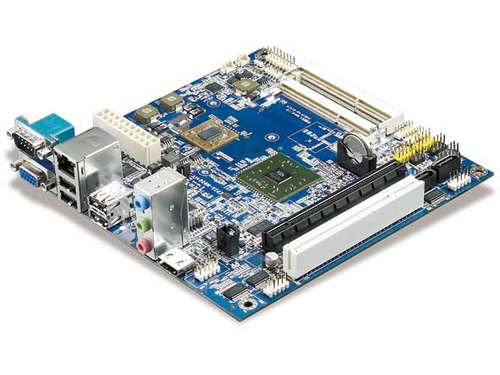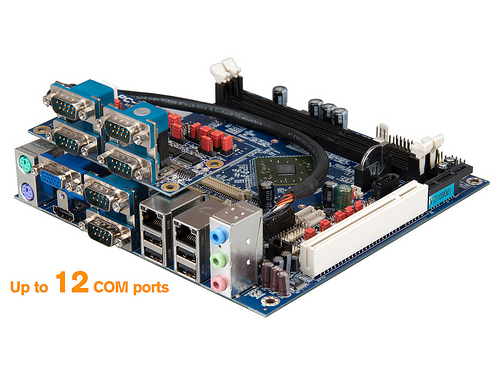VIA Intros "World's First" Quad-Core Mini-ITX Boards
VIA has reintroduced two mini-ITX boards that now support its 1.2 GHz VIA QuadCore E-Series processor.
On Thursday Taiwanese motherboard and chipset manufacturer VIA Technologies claimed "world's first" by reintroducing the VIA EPIA-M900 and VIA EPIA-M910 boards as the company's first two Mini-ITX boards to feature it's 1.2 GHz VIA QuadCore E-Series processor. VIA says they're the most power efficient x86 quad-core solutions available on the market, targeted for "immersive" HD embedded environments.
The VIA EPIA-M900, which originally launched in July 2011, measures 17 x 17-cm and now comes packed with either the QuadCore E-Series processor, or the 1.6 GHz dual core VIA Nano X2 E-Series processor. Also on board is the VIA VX900 Media System Processor (MSP) which features the VIA ChromotionHD 2.0 video processor and supports up to 8 GB of DDR3 system memory. The rear panel I/O includes a Gigabit LAN port, HDMI port, VGA port, four USB 2.0 ports, one COM port and three audio jacks.
"An onboard PCIe x16 slot (with effective speed up to PCIe x8) and one PCI slot is accompanied with pin headers providing one dual channel 24-bit LVDS support (including backlight control), an additional three COM ports, a further four USB 2.0 ports and one USB device port, LPC support, 2 Digital I/O, SPDIF out and an SMBus header," VIA said on Thursday.
As for the VIA EPIA-M910, it launched just two weeks ago. It's a bit meatier than the previous M100 board, now supporting the 1.2 GHz VIA QuadCore E-Series processor in addition to the 1.6 GHz VIA Nano X2 dual core processor and the fanless 1.0 GHz VIA Eden X2 dual core processor, depending on your budget. The rear I/O panel is packed with dual Gigabit LAN ports, PS/2 support, one HDMI port, a VGA port, two RS-232 5v/12v selectable COM ports, four USB 2.0 ports and audio jacks.
"On board pin headers provide 2 x 24-bit LVDS support (including backlight control), two SATA ports, an additional six COM ports, a further four USB ports, Digital I/O, and a PCIe x4 slot. The VIA EPIA-M910 is available with support for either ATX or DC-in power supplies," VIA said.
VIA also stated that the QuadCore E-Series processor features a highly optimized, energy efficient multi-core architecture that delivers a thermal design power (TDP) of only 27.5W. It's also natively 64-bit compatible and comes with numerous performance features including Adaptive Overclocking.
"The VIA QuadCore E-Series processor delivers world class performance in the industry's leading power efficient package,"VIA said. "The high performance of the VIA QuadCore E-Series processor makes it the perfect platform for the creation of next generation digital signage displays and embedded projects."
Get Tom's Hardware's best news and in-depth reviews, straight to your inbox.
Actual availability and pricing is unknown, so stay tuned.

Kevin Parrish has over a decade of experience as a writer, editor, and product tester. His work focused on computer hardware, networking equipment, smartphones, tablets, gaming consoles, and other internet-connected devices. His work has appeared in Tom's Hardware, Tom's Guide, Maximum PC, Digital Trends, Android Authority, How-To Geek, Lifewire, and others.
-
coreym72 Keep designing boards smaller and smaller and I look forward to assembling my own tablet just like a PC. OS installed from a bootable flash card (WIM Image) or any OS even a hackintosh. Apple may have a head start but I’m not one to be glued to a company where all the apps are purchased from.Reply -
velocityg4 They may be the worlds first embedded CPU mini-ITX board. But for a couple years now you've been able to plop a quad core Intel or AMD CPU into mini-ITX boards.Reply
What I want is a cheap ARM board with RAID 5 capabilities. That way I can build an inexpensive and low power using NAS. The Atom uses too much electricity and so does this. The prebuilt NAS with an ARM CPU use less energy but are way overpriced.
I say they are overpriced since the prebuilt NAS with ARM cost less than the Atom models. Yet I can build an Atom NAS for less than a prebuilt ARM NAS. Therefore being able to build your own ARM NAS should be far cheaper than the prebuilt model. Plus have 2GB+ RAM as that seems to be a huge performance hit in the cheaper prebuilt NAS that only have 256MB or 512MB. -
artk2219 Honestly what I would like to see are some good VIA reviews since we see Brazos and Atom reviews fairly often but there isn't much information in regards to where VIA stacks up in all of this. Graphics wise I know their chips are absolutely terrible, but I remember when Brazos was released I saw something with the VIA x2 more than holding its own in a preliminary review, well holding its own on the CPU side at least.Reply -
COLGeek Would make a decent low-power home server rig. Not really a great deal of mainstream use however due to the lack of processing horsepower. Still, when used for the correct purposes, these products could be very useful.Reply -
CaedenV velocityg4The Atom uses too much electricity and so does this. The prebuilt NAS with an ARM CPU use less energy but are way overpriced.I say they are overpriced since the prebuilt NAS with ARM cost less than the Atom models.Atom processors take a Max of 10W, and substantially less when at idle. A low power HDD takes 3-5W idle and between 10-25W when in use (35-50W on spin-up). If your CPU takes less (approximate 1/2) the power of your HDD, and costs 67 cents per month if under a full load 24/7 (365d/y*24hr/d*10W/hr/1000W/kW=87.6W/yr /12mo=7.3kW/Mo*9.3cents/kW=67cents/mo) and you are worried about the cost of operation, then you have issues my friend. Obviously the costs will vary depending on location, but 9.3 cents is the national average, but we are still talking well under $1/mo to run your processor at full tilt for a whole month. Used 8 hours a day we are talking closer to 22 cents a month. Sure, if you are running a server farm of 1000 of these puppies, plus business rate for power which is much higher, then we are talking some serious cash... but as a home user you are being silly.Reply
As for the article; It's good to hear Via is still in the mix. They were the best low power company for a very long time, and I would love to see them come out with some ground-breaking stuff again! -
gilbertfh caedenvAtom processors take a Max of 10W, and substantially less when at idle. A low power HDD takes 3-5W idle and between 10-25W when in use (35-50W on spin-up). If your CPU takes less (approximate 1/2) the power of your HDD, and costs 67 cents per month if under a full load 24/7 (365d/y*24hr/d*10W/hr/1000W/kW=87.6W/yr /12mo=7.3kW/Mo*9.3cents/kW=67cents/mo) and you are worried about the cost of operation, then you have issues my friend. Obviously the costs will vary depending on location, but 9.3 cents is the national average, but we are still talking well under $1/mo to run your processor at full tilt for a whole month. Used 8 hours a day we are talking closer to 22 cents a month. Sure, if you are running a server farm of 1000 of these puppies, plus business rate for power which is much higher, then we are talking some serious cash... but as a home user you are being silly.As for the article; It's good to hear Via is still in the mix. They were the best low power company for a very long time, and I would love to see them come out with some ground-breaking stuff again!Reply
It all adds up right? /sarcasm -
yumri4 if VIA jumps back with a good CPU design with their unique processing design which allows you to go on in a instruction without having to wait for all the other cores to finish then yeah VIA will be a good low end system board choice again but i do not see them measuring up to Intel and/or AMD anytime soon but on the end of price they are cheaper to build with thus might be put into some of the thinner and cheaper mobile devices and/or embedded systems like a ATM and stuff like that where high performance isn't really an issue just reliability.Reply

